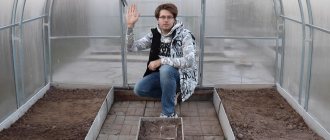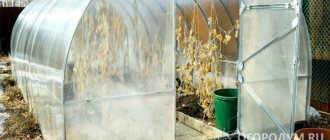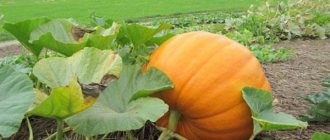Choosing the right landing time
To choose the right time for planting, you must first decide what kind of harvest we want to get and how much. And then pay attention to several factors influencing this:
- Variety and time of year of planting. Using different types and time periods, you can provide yourself with fresh fruits for almost the entire season, and maybe even a year.
- Climate of the region. Depending on weather conditions, radishes are planted earlier, later, or artificial approaches are used to create the necessary conditions for growing.
- Planting location - open ground, greenhouse, balcony or under film.
To correctly calculate the date of planting radishes, they are first determined by when the first harvest should be obtained. From this, the time for seed germination (3-5 days) and the remaining time required for cultivation (3 weeks) are subtracted. This way you can calculate a fairly accurate date.
Where can I buy seeds?
Radish seeds are an inexpensive pleasure. You can buy them in almost any hypermarket or specialized gardening stores.
- In Moscow, for example, you can buy seeds in the well-known Auchan hypermarket chain, in the Bejo seed store (for example, near the Kolomenskaya metro station) or in Semko-Yunior on Rizhsky Proezd.
- In St. Petersburg it is still the same “Auchan”, “SortSemOvoshch” or “House of Seeds”.
- In absolutely any city you can buy radish seeds in online stores.
Prices for radish seeds vary greatly - from four rubles for popular and common varieties to ninety for new and rare varieties. Also, the price greatly depends on the supplier and the store itself.
When to plant radishes in 2022
Radish seeds germinate at a temperature of +1..2ºС, but the air temperature should be within 15-20ºС for normal development.
This is one of the most important conditions that affects planting dates.
Let's look at other factors in more detail.
Depending on the variety and time of year
At the beginning of spring, early varieties are planted first, but several can be planted at once. This will make it possible to receive a new one every 10 days, after the first harvest. Varieties suitable for this are French Breakfast, Heat, Dungan.
To prolong the harvest, radishes are replanted when the first 2 leaves appear on the previous batch.
This can be done in the first half of May. In the future, due to the long daylight hours, the root crops will not develop properly.
Still, radishes are sown in the summer, but they are covered in the evening and at night with dark cloth or film. Here it is better to use varieties that do not shoot an arrow:
- Quart;
- Children's F1;
- Rhodes;
- White Nights;
- Verovsky;
- Champion.
The deadline for sowing radishes is mid-August. Late varieties for autumn and winter consumption are suitable here - Red Giant, Zlata, Cherriet F1. You can plant early varieties, but they will not be stored; they must be consumed immediately.
Radishes are also planted before winter in prepared beds. This falls at the end of November beginning of December. The main thing is that the seeds do not have time to germinate. The varieties that have proven themselves to be suitable for this method are Zarya and Zhara.
The best varieties of radishes that are sown all summer:
- Lydia;
- Pharaoh;
- Firefly;
- White Nights;
- Sora.
Depending on the region
In the middle zone and in the Moscow region, radishes begin to be sown from the last days of March to the last days of May. Approximately taking breaks between sowings for 10 days. But first they use greenhouses, and from the end of April open ground.
In the Leningrad region, radishes are planted directly into the ground in May. It is better to start in mid-May, and in a greenhouse you can sow a month earlier.
In the south of Russia, for example, in Kuban, radishes can be planted starting at the end of February, even if the soil has not yet warmed up. In unheated greenhouses this can be done all year round.
In Ukraine and Belarus, the timing of planting radishes in the northern regions is comparable to the Moscow region. In the southern regions of these countries, planting begins in the Krasnodar Territory and Crimea - early or mid-March, but this month they mainly use a greenhouse.
Video. When to sow radishes in Siberia and what varieties
Depending on landing location
You can start planting in a polycarbonate greenhouse as early as March, when the temperature during the day is within +15-18ºС, and at night +8-10ºС.
In the last days of March, you can sow radishes in greenhouses made of film, and from the second ten days of April - in open ground under film on arcs. They just plant it in an open place at the end of April.
Radishes are grown at home on a balcony or windowsill
It is important to provide the necessary temperature conditions and lighting. In order to have enough natural light, they begin to sow it in the third ten days of January, placing boxes on southern windows. And in the first ten days of February on the eastern and western sides.
It is very important to fulfill these conditions, otherwise only the tops will grow.
Lunar calendar for planting radishes in 2022
It is very convenient to use favorable days according to the lunar calendar for sowing radishes. First of all, you need to pay attention to full moon days.
All favorable days:
- January: 25-27, 29-31
- February: 4-9, 12-14, 21-27
- March: 6-8, 11-13, 20-31
- April: 3-5, 7-10, 17-22, 25-30
- May: 2, 5-7, 10-12, 17-25, 27-29
- June: 1-3, 6-8, 15-17, 23-26
- July: -
- August: 8-10, 13, 14, 22-24, 29-31
- September: 5-7, 23-25, 28-30
- October: 2-4, 8-12, 15-18, 20-22, 27-31
- November: 3, 4, 12-14, 21, 23
- December: 2-4
In 2022, unfavorable days fall on the following dates:
- January – 2, 3, 17, 18
- February – 1, 2, 16, 28
- March – 1, 2, 18, 27, 28
- April – 1, 2, 16, 23
- May – 1, 16, 30
- June -14, 18, 29
- July – 13, 14, 28, 29
- August – 11, 12, 27-28
- September: 9-10, 26, 27
- October: 9, 10, 25, 26
- November: 1, 2, 7-9, 24, 25, 28, 29
- December: 7-9, 23-25
When to start sowing radishes to get a super early harvest?
Early sowing is considered to be sowing, which is carried out with the first manifestations of spring and the retreat of cold weather. For early sowing in closed ground, choose varieties with a fast ripening period - 15-25 days (you can find out how long radishes grow in a greenhouse, on what day they sprout and what the ripening time is here). The first seeds are sown in early March, this allows you to rationally use the soil and grow a crop of early radishes before planting heat-loving crops (tomatoes and cucumbers) in late spring.
Early varieties of radish in cool growing conditions give a high-quality harvest, do not allow shoots to form and do not grow wild tops.
- Before sowing, the soil is loosened and leveled, sprinkled with a thin layer of snow and the crop is sown directly on slightly compacted snow. When the snow thaws, the seeds will sink into the soil.
- In another sowing option, the seeds are first sown on the soil, sprinkled with a small layer of soil, and only then a thin layer of snow is laid. This method will simultaneously harden the seeds and moisten the soil.
How to plant radishes in a greenhouse and soil
In spring, radishes are one of the first vegetables in the garden. Growing it is not the most difficult task in the garden, but it has its own recommendations.
How to prepare seeds
Before sowing, the largest seeds with a diameter of 3 mm or more are first selected. And the remaining ones can be sown separately to obtain greens or thrown away if they are not needed.
Good seeds are planted immediately in moist soil or treated against diseases and for better germination. Some recipes:
- Seeds are germinated during the day on a damp cloth.
- To protect against dry rot, they are placed in water at a temperature of +45ºC for 15 minutes. The same recipe will help for quicker and earlier germination.
- The third method involves soaking the seeds in a solution of a special drug to stimulate growth.
What place to choose. After which you can and cannot plant
It is better to plant radishes in sunny places, perhaps with light shade. It grows at temperatures ranging from +18-20ºС. Before planting, you need to take into account that this vegetable ripens quite quickly. Therefore, after harvesting, other plants can be planted in its place.
Any type of greens or Chinese cabbage are perfect for this purpose. But it is more convenient to save space by planting it next to other crops, using row spacing. Suitable options include onions, tomatoes, cucumbers, white cabbage and carrots.
Then plant radishes:
- tomatoes;
- cucumbers;
- legumes;
- potato.
After which you don’t need to plant:
- turnip;
- horseradish;
- cabbage;
- daikon;
- turnip;
- salad;
- horseradish.
In summer, radishes are planted in places with shade, as they need shorter daylight hours to ripen.
Soil for planting
Loose sandy loam soils are best suited for radishes. It does not tolerate high acidity.
Land preparation begins in the fall, and it does not matter how the radishes will be grown - open ground or a greenhouse. They dig up the area to the depth of a bayonet shovel and apply organic fertilizers - humus, compost. In the spring, the soil is dug up again under the beds, but not so deep, about 2/3 of a bayonet. This time phosphorus and potassium are added.
Planting radishes
Radishes are planted with seeds directly into the ground or seedlings are grown. The second method allows you to save up to 1.5 weeks. Seeds for seedlings can be grown in the ground, or in a snail on a wet cloth without soil.
The seedlings are transplanted 5-6 days after sowing. To do this, furrows are made, seedlings are placed at a distance of 6-8 cm and sprinkled with soil. After planting, the crops are watered. If the soil is fertile, then there is no need to add fertilizer to the holes.
Video: How to plant radishes as seedlings without soil (in a snail)
How to plant radishes in a greenhouse
Not every variety is suitable for planting radishes in a greenhouse or greenhouse. Therefore, we need to start with this.
What varieties of radish are best to plant in a greenhouse:
- Greenhouse;
- Zarya;
- Heat;
- Sachs;
- Early red.
If the greenhouse is heated, then the vegetable can be grown throughout the year. Preparing the premises begins 2 weeks before planting: repairing and covering with film. In this case, the soil in the beds will have time to thaw and warm up. Planting can begin as soon as the five-centimeter layer of soil becomes soft.
The rows are made with a distance of 10-20 cm, the seeds are buried 1 cm. If the seeds do not need to be saved, then they are sown quite densely and then thinned out or replanted. And if not, then the distance between them should be about 5 cm.
In a greenhouse, it is important to maintain humidity levels and temperature conditions:
- While the seeds germinate, it is kept at a level of +16-18ºС.
- When mass shoots appear, the temperature is kept at +6-8ºС for 4 days.
- In the future, during the day the temperature should be + 15-20ºС, and at night + 8-10ºС.
In general, care is not very difficult. Watering of seedlings is carried out as needed, but not less than once every 2-3 days. The soil should get wet up to 15 cm deep.
How to plant radishes in open ground correctly
Before sowing radish seeds in the ground, furrows are first made to a depth of 3 cm, 20 cm are left between the rows, and they are sown at a distance of 5-6 cm in the row. But you can first plant it quite densely, and then thin out the seedlings, leaving these distances.
Having finished planting, the beds are mulched and covered with film. This will allow you to get earlier shoots and, accordingly, an early harvest. In the future, it is necessary to ensure regular watering (every day). Otherwise, the fruits will be small and bitter.
What varieties of radish are best to plant:
- Ronda F1;
- French breakfast;
- Ilka;
- Duro;
- Heat;
- Sachs;
- Faith;
- Champion;
- Dungan.
Video: How to plant radishes in egg cells in a greenhouse
Video from Yulia Minyaeva: Method of planting radishes in open ground
Features of sowing radishes before winter
Pre-winter sowing of radishes is carried out to obtain an early harvest. And also with this method of planting, the plant gets sick less and shows better growth rates than with spring planting. The main thing is not to miscalculate the deadlines - they are indicated earlier. Otherwise, the radishes may simply freeze.
The beds are prepared as early as possible, preferably a month in advance, but 1-2 weeks in advance is also possible. It will be good if all this work can be completed by mid-October. The same steps are carried out as for any other type of planting. The soil is dug up, fertilizers are added, if the soil is hard, then peat or sand is added.
Furrows are made to a depth of 5 cm and at a distance of 10-20 cm. Since the ground may be frozen during planting, the part necessary for filling the seeds is stored in a warm place or simply bought in a store. Before planting, the beds are covered with film to avoid soil erosion by rain.
Seeds are sown in the furrows as densely as possible; the quantity should be 2 times greater than with conventional sowing. Sprinkle with a two-centimeter layer of warm soil, mulch with grass, 5 cm thick. If possible, you can sprinkle the beds with a 20-centimeter layer of leaves for the winter.
If all the conditions are met, then you can get a good early crop of radishes in the spring.
Vegetable care
When growing radishes in spring and winter, they are illuminated in the morning and evening using lamps. There is no need to provide additional illumination for more than 12 hours, otherwise arrows will appear. Water regularly and abundantly, only then will the fruits be juicy. The soil must not be allowed to dry out. In dry soil, radishes will grow small, not tasty, and fibrous. In the greenhouse, it is advisable to organize automatic watering using rotating sprayers or use drip irrigation. Then the beds will not need to be loosened often. Plants in cassettes are watered from below through drainage holes. A polycarbonate greenhouse should be ventilated daily, because radishes do not tolerate humid air well. If this is not done, then she may get sick, for example, a disease such as black leg will develop.
It is not enough to sow the seeds correctly; it is necessary to provide adequate nutrition to the emerging seedlings. At first, the nutritional components introduced earlier are enough for them. However, fertilizers added to the ground in the fall are not enough for normal growth. It is necessary to apply the fertilizers that were used before planting and in the same quantity. When 2 true leaves appear, the seedlings are thinned out. The weak ones are removed, the remaining ones should be 5 cm apart from each other. In a greenhouse, plants often suffer from pests and diseases. As a preventative measure, they are sprayed with a 2 to 1 solution of ash and soap. The product repels cabbage moths, caterpillars and fleas, and prevents powdery mildew and blackleg from appearing.
Those gardeners who stick to planting days for radishes can already get a harvest in April. It is imperative to follow the rules of agricultural technology and listen to the recommendations of experts. When sowing seed material, you should take into account the zodiac signs in which the Moon is currently located. It is recommended to start work when it is in Scorpio, Libra, Cancer, Taurus and Pisces.
Recommendations from gardeners
Experienced gardeners advise growing radishes for sale, as they grow relatively quickly. And if you apply a sowing frequency of 10 days, use different varieties and growing methods, then you can have a constant income all year round.
Experience has shown that, if possible, it is better to avoid sowing radishes in months with long daylight and hot days. A lot of expenses go into growing, and the result is not always pleasing. It's better to skip June and July.
Tricks for planting radishes in a greenhouse from Yulia Minyaeva
Varieties for polycarbonate greenhouses
To grow in a greenhouse, you need to take early ripening varieties that do not last long, and the root crops grow small. Ultra Early is considered one of the best. Radishes have a round shape. These red fruits have an excellent taste and grow in weight up to 15 g. From the green leaves, while they are young, you can prepare a salad. The early variety Zarya pleases with round fruits weighing 20 g. They are not bitter, the white flesh is tender and juicy. The ultra-early hybrid Children's F1 is ready for consumption after 20 days. Radishes have a mild pungent taste and juicy flesh.
Benefits and contraindications
The main benefit is the content of carbohydrates, vitamins, proteins, nitrogenous and ash substances, mineral salts and phytoncides. The largest number of them is found in the leaves.
It improves blood circulation, fights obesity, fiber removes cholesterol, normalizes blood sugar levels, and prevents cancer.
Not recommended for people with serious gastrointestinal problems. In this case, consume it no more than once a week, but it is better to boil it.
Possible problems during cultivation
Radish is an unpretentious plant, but a number of problems may arise when growing it. Here are the most common ones.
- Soil inadequacy. Radishes prefer loose sandy loam or loamy moist soils with good air permeability, with a reaction close to neutral. With any deviations from these conditions, changes in plant development will be noticeable, expressed in slower growth, yellowing of leaves, and the appearance of diseases.
- Disruptions in care. First of all, this concerns non-compliance with planting deadlines, significant deviations from the watering schedule, violation of the length of daylight hours, and non-compliance with recommended temperature parameters. In this case, instead of forming a root crop, the radish may grow into an arrow. An excess of fertilizers, especially nitrogen-containing ones, can lead to the same result.
What to do if the radishes are very stretched in the greenhouse
When planted in a greenhouse, radishes may stretch for several reasons. The most common of them are too high daytime temperatures and dense plantings. To avoid this, it is necessary to regularly ventilate the greenhouse and not allow the daytime temperature in it to rise above + 20-22 °C. You also need to monitor the density of the crops, thinning them in a timely manner.











